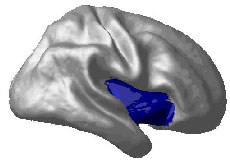北京师范大学认知神经科学学习研究所贺永老师及其合作者于2009年在Brain杂志上发表了题为“Impaired small-world efficiency in structural cortical networks in multiple sclerosis associated with white matter lesion load”的研究论文。该篇文章是关于白质多发性硬化病脑结构网络的拓扑效率与白质病变体积的关联研究,由贺永老师和加拿大McGill大学的Alan Evans教授的研究团队合作完成。
白质多发性硬化病(Multiple Sclerosis)是一种常见的以中枢神经系统炎性脱髓鞘为特征的疾病。早期的神经影像学研究已经发现病人在多个脑白质结构上具有病变,最近的研究也发现病人在局部灰质结构上具有异常。但是,在脑灰质区域构成的结构网络整合上是否表现出异常,目前仍不清晰。在这项研究中,贺永及其合作者利用磁共振成像技术获得的脑结构图像,结合基于计算神经解剖的皮层映射技术获得的大脑皮层厚度数据,构建了人脑的结构连接网络(图1)。进而用现代图论的计算方法定量描述了病人的脑结构网络效率是如何随着白质病变体积变化的。
贺永及其合作者发现,病人的脑网络即使在疾病条件下也具有高的局部和全局整合效率(即表现出“小世界”拓扑属性),这一研究结果与该研究团队先前在健康被试中的研究保持一致。进一步研究发现,白质多发硬化病人的网络效率随着白质病变的体积呈现出一定比例的减弱,而且最为严重的减弱发生在脑岛、中央前回及额颞叶皮层区域。这项研究表明了白质多发硬化病人的白质病变程度严重影响了脑结构网络的信息传输效率。基于上述研究结果,他们提供了国际上第一个白质多发硬化病脑结构网络整合异常的模型,为该疾病的“失连接”概念提供了结构证据。
三位论文审稿人一致认为,该研究所采用的研究方法是高度创新的,结果是非常令人感兴趣的,可能具有高的临床研究价值。
推荐英文摘要:
Brain. 2009 Dec;132(Pt 12):3366-79. PMID: 19439423
Impaired small-world efficiency in structural cortical networks in multiple sclerosis associated with white matter lesion load.
He Y, Dagher A, Chen Z, Charil A, Zijdenbos A, Worsley K, Evans A.
State Key Laboratory of Cognitive Neuroscience and Learning, Beijing Normal University, Beijing 100875, China.
White matter tracts, which play a crucial role in the coordination of information flow between different regions of grey matter, are particularly vulnerable to multiple sclerosis. Many studies have shown that the white matter lesions in multiple sclerosis are associated with focal abnormalities of grey matter, but little is known about the alterations in the coordinated patterns of cortical morphology among regions in the disease. Here, we used cortical thickness measurements from structural magnetic resonance imaging to investigate the relationship between the white matter lesion load and the topological efficiency of structural cortical networks in multiple sclerosis. Network efficiency was defined using a 'small-world' network model that quantifies the effectiveness of information transfer within brain networks. In this study, we first classified patients (n = 330) into six subgroups according to their total white matter lesion loads, and identified structural brain networks for each multiple sclerosis group by thresholding the corresponding inter-regional cortical thickness correlation matrix, followed by a network efficiency analysis with graph theoretical approaches. The structural cortical networks in multiple sclerosis demonstrated efficient small-world architecture regardless of the lesion load, an organization that maximizes the information processing at a relatively low wiring cost. However, we found that the overall small-world network efficiency in multiple sclerosis was significantly disrupted in a manner proportional to the extent of total white matter lesions. Moreover, regional efficiency was also significantly decreased in specific brain regions, including the insula and precentral gyrus as well as regions of prefrontal and temporal association cortices. Finally, we showed that the lesions also altered many cortical thickness correlations in the frontal, temporal and parietal lobes. Our results suggest that the white matter lesions in multiple sclerosis might be associated with aberrant neuronal connectivity among widely distributed brain regions, and provide structural (morphological) evidence for the notion of multiple sclerosis as a disconnection syndrome.








